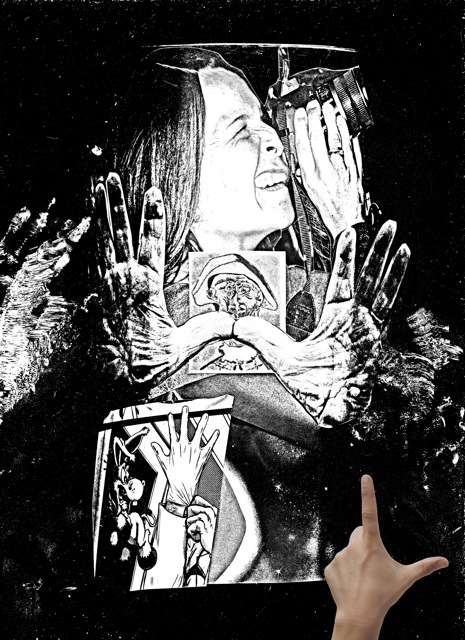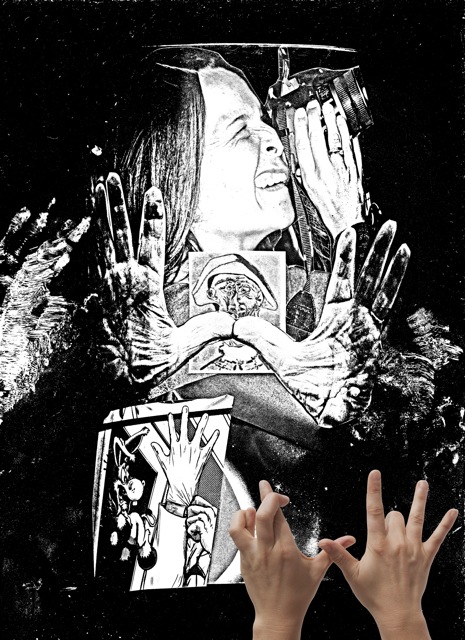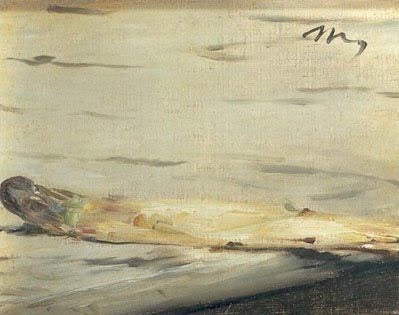Single Asparagus
June 1st, 2013
Karen Archey interviews artist Lucie Stahl for the June 2013 edition of the Artist of the Month Club.
KAREN ARCHEY: You’ve employed the flatbed scanner as a primary tool in your artistic practice for years; your work often being likened to a digital-age photogram. Can you speak about your decision to utilize this rather specific image-making tool?
LUCIE STAHL: I’m quite an impatient person so the immediacy of the process is nice.

It is of course a bit like making photograms but without the inconvenience of having to stand around in a dark room full of chemicals all day. It gives me time to do a lot of stuff I’d rather be doing than making art. I’m often asked about the process and presentation of photography in relation to my work and the usage of the scanner, but my work is not necessarily about photography. Of course it is unavoidable but it’s just not something I think about. I think more about the stuff that surrounds us in general. Photography is one of those things. I don’t really distinguish between the frame and the content.
KA: Your hands make frequent appearance in your compositions. Sometimes they hold down images or objects onto the scanner, other times they’re covered in clay or appear as numerals, such as your piece here. It makes me think about facture, or “evidence of the artist’s hand,” a traditional concern in artistic production. It also references portraiture to me, the hand being a fairly gender-neutral part of the body, scanner being a new way to picture the body. Are the hands in your work symbolic of such concerns?
LS: Yes. The artist’s presence – it is sort of a joke, with this kind of image making, but a serious one, too. I’ve considered asking people with prettier hands to do the job, but somehow I always come back to my own mitts. I like your description of the hands as being gender neutral.
I’m almost tempted to say it is also age neutral. I always think my hands look like baby-grandpa hands.
I’ve recently been to the Museo Nacional de Antropología in Mexico City and they have all these great ceramics of hands and feet. There’s something very humble about that. Human, I guess. Like the prints in the Chauvet caves. What a wonderful movie. I can’t believe I missed to see it in 3D. Herzog’s a genius. I like assholes. I’m very literal, I don’t do abstraction.
KA: Speaking of serious jokes, your work has previously employed lines from famous comedians printed onto text and placed on the scanner. A lot of these lightheartedly broach very serious topics–how do you use humor as a tool in your practice?
LS: Correct me if I’m wrong, but I think I’ve only ever used quotes of one famous comedian – George  Carlin – in some of my early scanned works. Watching his stuff was a bit of an epiphany for me. We don’t get much good Stand Up in Germany. Since then I moved on to other Stand Up Comedians. I like Kristen Schaal. I might have stolen or borrowed the occasional idea or used a similar text structure, no doubt. But yeah, I consider all those texts I wrote for the posters „serious jokes“. Or, almost all. Some of them are sheer sillyness. The joke, or humor, makes it possible for me to talk about, – I’m hesitant to say it but out of lack of another word I’ll call it – moral issues, without blushing. Someone told me I’m not a moral person but I’m morally hardwired. I can’t escape it. I don’t really know what it means but I agree.
Carlin – in some of my early scanned works. Watching his stuff was a bit of an epiphany for me. We don’t get much good Stand Up in Germany. Since then I moved on to other Stand Up Comedians. I like Kristen Schaal. I might have stolen or borrowed the occasional idea or used a similar text structure, no doubt. But yeah, I consider all those texts I wrote for the posters „serious jokes“. Or, almost all. Some of them are sheer sillyness. The joke, or humor, makes it possible for me to talk about, – I’m hesitant to say it but out of lack of another word I’ll call it – moral issues, without blushing. Someone told me I’m not a moral person but I’m morally hardwired. I can’t escape it. I don’t really know what it means but I agree.
KA: Your new images of trash cans remind me of a teenager’s bedroom wall collage, or a piece of furniture wheat pasted with images cut out from magazines. They feel pretty intimate and residential, and remind me of our yesteryears collecting magazines and National Geographics for collage source material. Do you primarily work with printed material? And why use a residential object such as a waste bin?
LS: Yes, the trashcan collages are very pre-pubescent.
All the material collaged on there is stuff that I collect from magazines and newspapers. It might be yesteryears’ material but it’s still stuff around, so it’s nice to use it. I like the idea of reading the newspaper in print but then I feel guilty when they pile up cause I end up just flicking through the online version, so going through them one more time seems appropriate. Isn’t there a very silly movie about somebody reading each newspaper to the fullest and therefore always is years behind?! I guess it was a short story once in the New Yorker. I didn’t even like it so much but somehow it got stuck in my brain. I hardly ever read the old news though.
I also still like what it says in the press release for the „Waste“ show at dépendance, where I first showed them:
‚The trash bins have been heavily and roughly collaged with images from magazines and newspapers depicting various subjects, scenes and scenarios. The collaged elements were edited and arranged to speak either directly or obliquely to their condition of being on the outside of a trash bin and in dirty hands.‘
KA: Where are the clippings from “Hand in Glove” sourced from? The painting, photo, donkey illustration, photo of the woman, etc.?
LS: Normally I don’t like giving away the sources too much – but, ok.
The painting is Picasso’s Harlequin Head, which was stolen in this crazy Rotterdam Heist. The hands are the ones of the former Federal Chancellor Helmut Schmidt. He’s a charismatic guy. The lady with the camera is a photo I took when the Endeavour rolled through Los Angeles. I joined my

friend Markus Krottendorfer for an afternoon, who was out day and night documenting the whole
trip of the shuttle. I’m not too interested in spacecrafts, I was there because I like crowds. Especiallygood looking kids of 16 or 17. I don’t even remember taking the picture of that lady but I really liked it once I saw it.
The donkey and gloved hand image is from a comic called Happy! by Grant Morrison and Darick Robertson.
KA: If you could own any piece of art in the world, what would it be?
LS: Manet’s single asparagus.